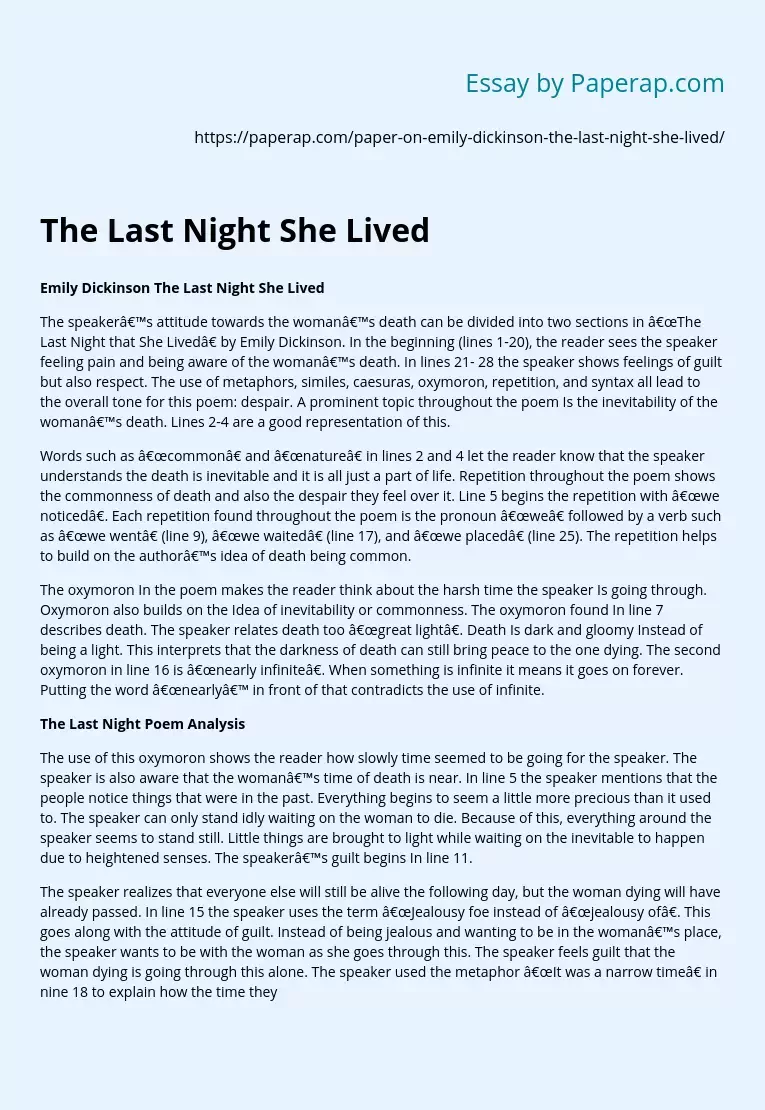Emily Dickinson The Last Night She Lived
The speaker’s attitude towards the woman’s death can be divided into two sections in “The Last Night that She Lived” by Emily Dickinson. In the beginning (lines 1-20), the reader sees the speaker feeling pain and being aware of the woman’s death. In lines 21- 28 the speaker shows feelings of guilt but also respect. The use of metaphors, similes, caesuras, oxymoron, repetition, and syntax all lead to the overall tone for this poem: despair.
A prominent topic throughout the poem Is the inevitability of the woman’s death. Lines 2-4 are a good representation of this.
Words such as “common” and “nature” in lines 2 and 4 let the reader know that the speaker understands the death is inevitable and it is all just a part of life. Repetition throughout the poem shows the commonness of death and also the despair they feel over it. Line 5 begins the repetition with “we noticed”. Each repetition found throughout the poem is the pronoun “we” followed by a verb such as “we went” (line 9), “we waited” (line 17), and “we placed” (line 25).
The repetition helps to build on the author’s idea of death being common.
The oxymoron In the poem makes the reader think about the harsh time the speaker Is going through. Oxymoron also builds on the Idea of inevitability or commonness. The oxymoron found In line 7 describes death. The speaker relates death too “great light”. Death Is dark and gloomy Instead of being a light.
This interprets that the darkness of death can still bring peace to the one dying. The second oxymoron in line 16 is “nearly infinite”. When something is infinite it means it goes on forever. Putting the word “nearly’ in front of that contradicts the use of infinite.
The Last Night Poem Analysis
The use of this oxymoron shows the reader how slowly time seemed to be going for the speaker. The speaker is also aware that the woman’s time of death is near. In line 5 the speaker mentions that the people notice things that were in the past. Everything begins to seem a little more precious than it used to. The speaker can only stand idly waiting on the woman to die. Because of this, everything around the speaker seems to stand still. Little things are brought to light while waiting on the inevitable to happen due to heightened senses. The speaker’s guilt begins In line 11.
The speaker realizes that everyone else will still be alive the following day, but the woman dying will have already passed. In line 15 the speaker uses the term “Jealousy foe instead of “jealousy of”. This goes along with the attitude of guilt. Instead of being jealous and wanting to be in the woman’s place, the speaker wants to be with the woman as she goes through this. The speaker feels guilt that the woman dying is going through this alone. The speaker used the metaphor “It was a narrow time” in nine 18 to explain how the time they had with the woman was slipping away.
The metaphor reiterates how quickly the time passed while waiting on the inevitable. The speaker’s pain in line 19 lets the reader know that the woman’s time to pass is closer than ever. The speaker states that their souls were “too Jostled to speak”. Even though the speaker knew this time was coming, it did not make the passing any easier at that moment. The death was common, but It was also a painful time to let go. The period In line 20 Is the speaker’s way of Identifying when the blur stopped.
It shows that the death Is even closer now than It was In the beginning of the poem. The “notice” the speaker mentions in that line is the death. The woman dying also represent this. The woman did not fight the death, but instead, she went “lightly as a reed”. This shows that the woman went peacefully. The speaker shows a great deal of respect for the woman in the final stanza. Even though the woman has died, the speaker wants to put her head into place and fix her hair. The speaker does not leave her side even after her life has passed.
Lines 27 and 28 show that even though the death was common, the speaker still must come to terms with all the emotions. The speaker uses another oxymoron in line 27. The “awful leisure” represents the speaker’s sadness about having to move on, but shows that the hectic time is now over. Leisure usually means that a person is at peace and rest while having a nice time. This leisure proves to be darker than normal. This allows everyone to comprehend what has happened. Line 28 states that life will soon “regulate” for the speaker once the emotions have calmed down.
The Last Night She Lived. (2019, Dec 05). Retrieved from https://paperap.com/paper-on-emily-dickinson-the-last-night-she-lived/

